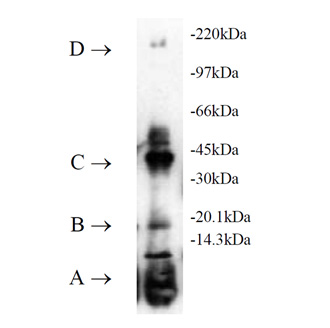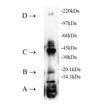Product Details
| MW: | ~22.2kDa |
| |
| Source: | Produced in E. coli. |
| |
| UniProt ID: | P62256 |
| |
| Formulation: | Liquid. In 20 mM Tris-HCl, pH 7.5, containing 0.5mM DTT. |
| |
| Purity: | ≥95% (SDS-PAGE) |
| |
| Biological Activity: | Recombinant UbcH2 charges and supports ubiquitinylation in vitro. |
| |
| Application Notes: | Useful for in vitro ubiquitinylation reactions. Typical enzyme concentration to support conjugation in vitro is 100nM to 1µM depending upon conditions. The His-tagged version of this enzyme is not susceptible to self-ubiquitinylation, which can occur with GST-tagged versions. |
| |
| Shipping: | Dry Ice |
| |
| Long Term Storage: | -80°C |
| |
| Use/Stability: | Enzyme is stable to multiple freeze/thaw cycles. |
| |
| Scientific Background: | Ubiquitinylation of proteins constitutes an important cellular mechanism for targeting short-lived proteins for degradation by the 26S proteasome. Three classes of enzymes are involved in the conjugation of ubiquitin to proteins. E1, the ubiquitin activating enzyme, activates ubiquitin through the ATP-dependent formation of a high-energy thiol ester bond between the carboxyl terminus of ubiquitin and the active-site cysteine within E1. This E1-activated ubiquitin is transferred to a cysteine residue of an E2, or ubiquitin-conjugating enzyme (UbC). E2 enzymes, either by themselves or in conjunction with E3 enzymes (ubiquitin ligases), then transfer ubiquitin to target proteins forming stable isopeptide bonds resulting in multi-ubiquitin chain formation. It is the diverse combinations of E2-E3 complexes which are thought to define substrate specificity.
UbcH2 is the human homolog to the yeast DNA repair gene RAD6, which is induced by DNA damaging reagents. It has been shown to conjugate ubiquitin to histone H2A in an E3 dependent manner in vitro, work which clearly demonstrated that UbcH2 consists of two functionally independent domains, an N-terminal core domain with ubiquitin conjugating activity, and a C-terminal domain which interacts with substrate proteins. UbcH2 has been associated with cancer-induced cachexia and with the regulation of sepsis-induced muscle proteolysis. |
| |
| Regulatory Status: | RUO - Research Use Only |
| |

Labels are as follows: A – biotinylated ubiquitin; B – probably biotinylated di-ubiquitin; C – biotinyl-ubiquitin thiol ester linked UbcH2; D – biotinylubiquitin thiol ester linked E1.
Please mouse over
Product Literature References
UBE2L3, a Partner of MuRF1/TRIM63, Is Involved in the Degradation of Myofibrillar Actin and Myosin: D. Peris-Moreno, et al.; Cells
10, 1974 (2021),
Abstract;
General Literature References
Sepsis is associated with increased ubiquitin conjugating enzyme E2 14k mRNA in skeletal muscle: S.C. Hobler et al.; Am. J. Physiol. 276, R468 (1999),
Ubiquitinylation of transcription factors c-Jun and c-Fos using reconstituted ubiquitinylating enzymes: M.L. Hermida-Matsumoto; J. Biol. Chem. 271, 4930 (1996),
Characterisation of functionally independent domains in the human ubiquitin conjugating enzyme UbcH2: P. Kaiser et al.; FEBS Lett. 377, 193 (1995),
Structural and functional conversation of two human homologs of the yeast DNA repair gene RAD6. : M.H. Koken et al.; Proc. Natl. Acad. Sci. USA 88, 8865 (1991),
The human ubiquitin carrier protein E2 (Mr=17,000) is homologous to the yeast DNA repair gene RAD6: R. Schneider et al.; EMBO J. 9, 1431 (1990),













